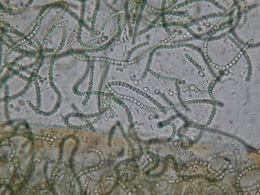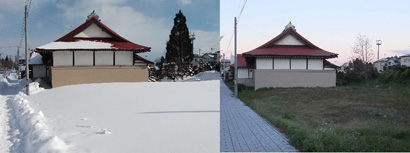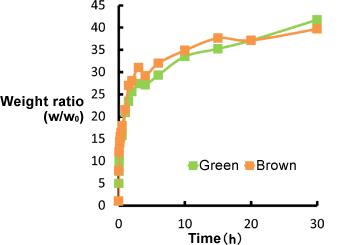Top>Research>Star Jelly: A fascinating Alga
 Index
Index

Hiroyuki Koike [profile]
Education Course
Star Jelly: A fascinating Alga
Hiroyuki Koike
Professor, Faculty of Science and Engineering, Chuo University
Area of specialization: Plant Physiology (using cyanobacteria to clarify the photosynthetic mechanism)
Introduction
Have you ever heard of star jelly (scientific name: Nostoc commune)? From a conventional standpoint, star jelly is a plant. However, it does not possess the normal plant characteristics of having roots, stems and leaves. Taxonomically speaking, star jelly is classified as a cyanobacterium, a type of alga. A cyanobacterium is an organism which lives by means of photosynthesis similar to plants. In other words, a cyanobacterium lives by using sunlight to fix carbon dioxide from the air and then generating starch. Although cyanobacteria are classified as algae, they do not possess a nucleus within its cells. Therefore, strictly speaking, it cannot be classified as an alga. Instead, a correct taxonomical classification would be “a photosynthetic prokaryote which performs oxygenic photosynthesis.”
My research laboratory is trying to clarify the mechanism of photosynthesis by using cyanobacteria. Star jelly is one type of material for clarifying the photosynthetic mechanism, which is one major theme of our laboratory. Another theme is clarifying the adaptive strategy of cyanobacteria which live in extreme environments. In other words, we are trying to shed light on the strategy used by cyanobacteria to survive in harsh environments.
Cyanobacteria living in extreme environments
Extreme environments are environments in which normal organisms cannot live. For example, in terms of temperature, extreme cold environments would be around -10 degrees Celsius, while extreme hot environments are about 200 degrees around hot water spots on the sea floor. Although scientists have yet to discover cyanobacteria which can live at temperatures of 100 degrees Celsius or higher, there have been reports of cyanobacteria living at 70 degrees. Such cyanobacteria are one of our research materials, and we refer to them as “hot spring cyanobacteria.” Returning to the original topic, environments can also be extreme in terms of pressure, ultraviolet rays, salt, pH, and other characteristics.
Regardless of various environmental conditions, water is the most important substance required for organisms to live. People cannot live without water. The same is true for cyanobacteria and other single-cell organisms. Life is not possible unless there is water inside the cell. Organisms living in extreme environments are also cellular based. Therefore, if water inside the cell decreases or freezes, the organism will stop life activities and die.
However, the cyanobacteria used as materials at our laboratory are alive (dormant) even when dried completely. If the dried cyanobacterium is exposed to water again via rain or other source, they return from the dormant state and begin photosynthesis. A paper describes that a sample stored at a museum for nearly 100 years returned from the dormant state when water was added back. Although it is impossible to confirm the validity of this report, it seems that cyanobacterium remains in a dormant state indefinitely when dried.
What is star jelly?

Figure 1 Star jelly cell

Figure 2 Dry star jelly (left) and swollen star jelly (right)
Star jelly consists of round, bead-like cells which are embedded in a thick, cold gelatin (Figure 1). In a dry state, star jelly appears to be a small, jet-black clump. However, when water is added, it expands greatly and appears green. Star jelly can absorb water equivalent to about 30 times its own weight and swell to the appearance of seaweed. Therefore, although star jelly is rarely noticed on sunny days, a green seaweed-like substance appears when rain falls. Accordingly, star jelly is also referred to as “land seaweed” (Figure 2).
You may be wondering where such a strange organism can be found. Actually, star jelly exists in most places throughout Japan. It can often be found in open areas of land which are strewn with pebbles and have somewhat high weeds. Other happy homes (?) for star jelly are the corners of unpaved parking lots, between blades of grass, and in the corners of school grounds. On a global scale, it is scattered from semi-tropical regions to polar regions. It is surprising to find star jelly even in the polar regions. Actually, an acquaintance of mine working at the National Institute of Polar Research told me that he found star jelly near the Showa Station in Antarctica. In other words, star jelly is resistant to both dryness and coldness. From that perspective, it is true that star jelly is found in environments which are covered with snow for several months in the winter. I just happened to find such a place at a region of Tohoku (Figure 3). During winter, even the daytime temperature in this region only reaches about 0 degrees Celsius. It is truly impressive that star jelly can live in such an environment. Star jelly has always been known as an organism resistant to dryness, but I have recently realized that it is resistant to cold as well.

Figure 3 Star jelly found in “City T” in Tohoku. The picture on the left is in February, while the right is June.
Changes in star jelly's photosynthetic activity when absorbing water and when dry
We are using this star jelly to examine how photosynthetic activity is recovered when water is added. Conversely, we are also investigating how photosynthetic activity disappears when dried. Although it is difficult to elucidate the reason why star jelly is resistant to dryness and low temperatures, we are gradually clarifying the phenomena which take place during moisturizing and drying processes.
Before discussing what takes place within star jelly during moisturizing and drying processes, I will first introduce the basics of photosynthesis. Photosynthesis starts with a reaction to absorb sunlight and concludes with the synthesis of starch. This process can be divided into a reaction occurring in the thylakoid membrane, a film structure existing inside cyanobacteria cells (in the case of plants, inside the chloroplast), and a reaction occurring in the cytoplasm (in the case of plants, a part of the chloroplast known as the stroma). The photosynthesis process can be divided into the following 3 major sub-processes.
- Absorption of light and transfer of energy.
- Conversion of light energy to oxidation-reduction energy and generation of oxygen.
- Carbon fixation and synthesis of starch.
The reaction for sub-processes 1 and 2 occurs in the thylakoid membrane, while the reaction for sub-process 3 occurs in the cytoplasm.

Figure 4 Swelling process of star jelly
When water is added to dry star jelly, the organism swells rapidly (Figure 4). This is similar to putting dried seaweed in water. When adding water, the star jelly absorbs 4 to 5 times its own weight in water during the first 3 to 4 minutes. About 30 minutes later, it will have swollen to about ten and several times its initial size. Afterwards, over a period of about 30 hours, the star jelly will slowly, continue to absorb moisture and expand, finally reaching 30 to 40 times its initial size. During this period, photosynthetic activity is recovered. The initial rapid absorption of water corresponds to recovery of sub-process 1. Recovery of sub-process 2 occurs during the next 30 minutes of absorption until the star jelly swells by about ten and several times. Afterwards, sub-process 3 is recovered over the next several hours.
As explained above, all photosynthetic reactions are not immediately recovered after absorbing water; instead, activity is recovered in several stages. Moreover, this recovery almost matches the order of reaction time when normal photosynthetic reaction occurs. For example, the simple physical process of absorbing light is completed in 10 to -12th (10-12) seconds, a period of time which escapes our recognition. On the other hand, the carbon fixation reaction takes several minutes to several dozen minutes. Stated differently, we can say that recovery is performed in the order of reaction. Now, how about when star jelly dries? As expected, activity is lost in the reverse order of recovery.
However, after some consideration, some people may notice points which defy explanation. For example, during the stage of absorbing water, star jelly can use light energy but is not capable of carbon fixation. This means that excess reducing power which could not be used for carbon fixation is accumulated within the cell. In the case of normal cells, this force would have a negative impact. Interestingly, star jelly easily overcomes this unstable state to return to its original form. Furthermore, when dried, star jelly enters a state of dormancy where photosynthesis is not possible. Even when in these state, star jelly located outdoors absorbs light to which it is exposed. If photosynthesis is not possible, there is no use for the light energy which has been absorbed. Normally, this energy would be used to break down the cell. In the case of star jelly, it is believed that energy is dissipated as heat or safely disposed of using some other mechanism. At the moment, we still have no clues as to what mechanism is used.
Where can star jelly be found?
For the reasons explained above, star jelly is an extremely interesting material from an academic perspective. As such, there are many points to be clarified. Allow me to introduce one more thing which I find fascinating. At the beginning of this article, I stated that star jelly can be found in most places throughout Japan. In truth, this statement isn't entirely correct. I have almost never seen star jelly around Tokyo. When I ask students, none of them have seen star jelly either. However, in the first place, students aren't interested in a seaweed-like substance found on the ground. Therefore, they would most likely forget even if they had seen it.
Getting back on subject, I have always wondered why I haven't seen star jelly in Tokyo. Perhaps it's because almost all of Tokyo is paved and there are few places where the ground is exposed. Even so, I have never seen star jelly at open spaces where the ground is exposed such as Meiji Jingu or Kita-no-Maru Park. Interestingly, star jelly is easily found on the Boso Peninsula. It is said that central Tokyo was at the bottom of the sea several thousand years ago. It is believed that the current topography was formed when sediment from the Tone River system caused the coastline to recede. The receding coastline was topped by acidic volcanic ash (Kanto loam formation) from volcanoes surrounding the Kanto Plain. I believe that this formation of the land is the reason why star jelly cannot be found today. Regardless of the truth of my hypothesis, I have always wanted to see star jelly growing in central Tokyo. If you have seen star jelly, please let me know!
- Hiroyuki Koike
Professor, Faculty of Science and Engineering, Chuo University
Area of specialization: Plant Physiology (using cyanobacteria to clarify the photosynthetic mechanism) -
Hiroyuki Koike was born in 1952 in Nagano Prefecture. He lived in Nagano City until graduating from high school. After graduating from Nagano Prefecture Nagano Senior High School in 1971, he enrolled in the Department of Biology at the Osaka University Faculty of Science. He entered the University of Tokyo Graduate School of Science in 1975 and completed the Doctoral Program in 1980. He holds a PhD in science. In 1981, he was appointed as a Research Associate of the RIKEN Solar Energy Research Group. In 1990, he was appointed as Associate Professor in the Department of Life Science at Department of Science, Himeji Institute of Technology. In 2004, he was appointed as Associate Professor at the University of Hyogo Graduate School of Science (change in organization/title). In 2006, he was appointed as Associate Professor at the University of Hyogo Graduate School of Science (change in title). In 2008, he was appointed as Professor in the Department of Life Sciences at the Chuo University Faculty of Science and Engineering.
His research involves using cyanobacteria to clarify the photosynthetic mechanism. In particular, by using cyanobacteria which lives in extreme environments, he seeks to clarify the electron transport chain of photosynthesis. In addition to the drought-resistant cyanobacteria introduced in this article, his research material includes thermophilic cyanobacteria. Other research includes examining the electron transport chain through a molecular biological method which uses ambient model cyanobacteria.
- Research Activities as a Member of Research Fellowship for Young Scientists (DC1), Japan Society for the Promotion of Science (JSPS) Shuma Tsurumi
- Important Factors for Innovation in Payment Services Nobuhiko Sugiura
- Beyond the Concepts of Fellow Citizens and Foreigners— To Achieve SDGs Goal 10 “Reduce Inequality Within and Among Countries” Rika Lee
- Diary of Struggles in Cambodia Fumie Fukuoka
- How Can We Measure Learning Ability?
—Analysis of a Competency Self-Assessment Questionnaire— Yu Saito / Yoko Neha - The Making of the Movie Kirakira Megane








